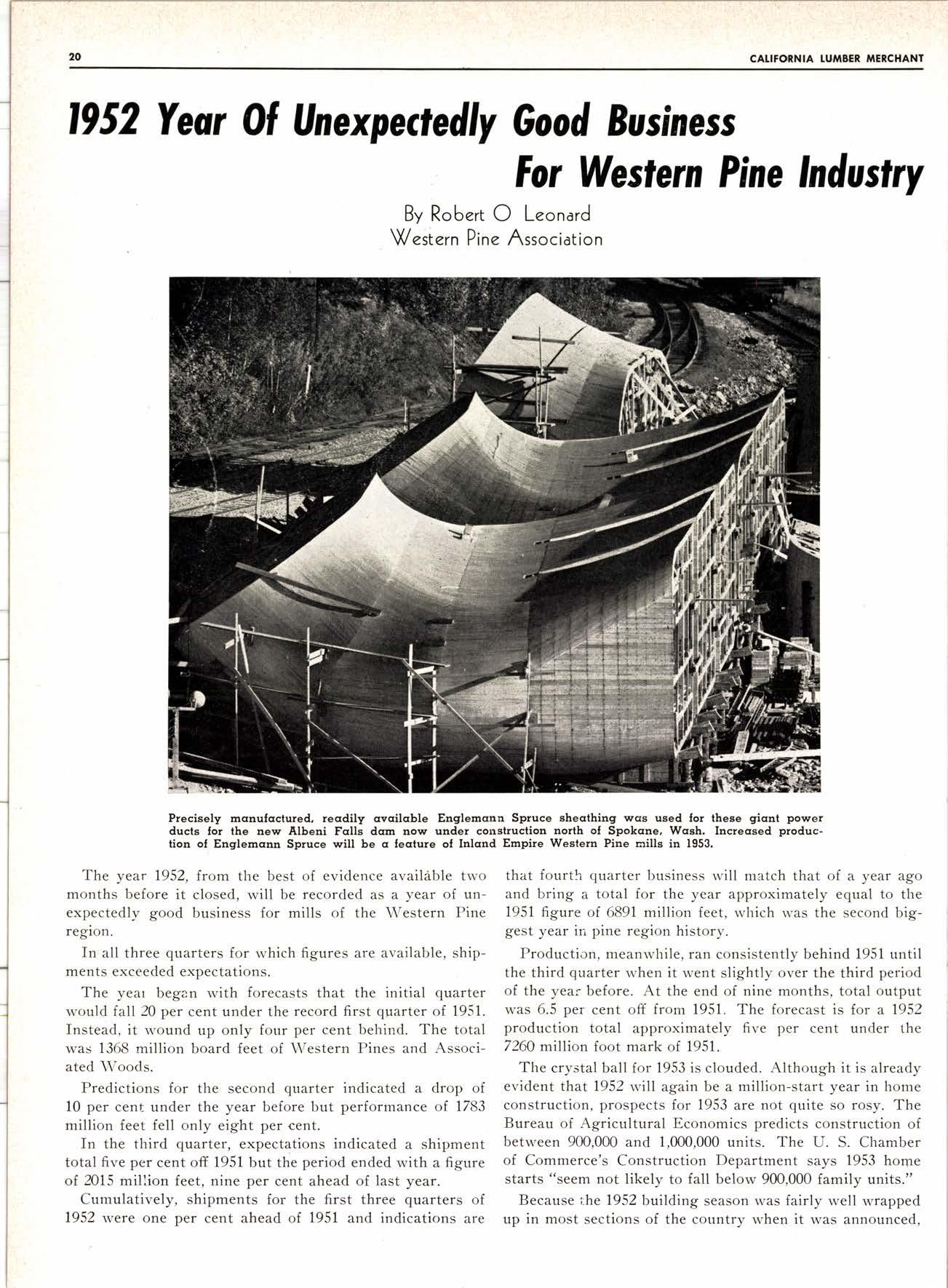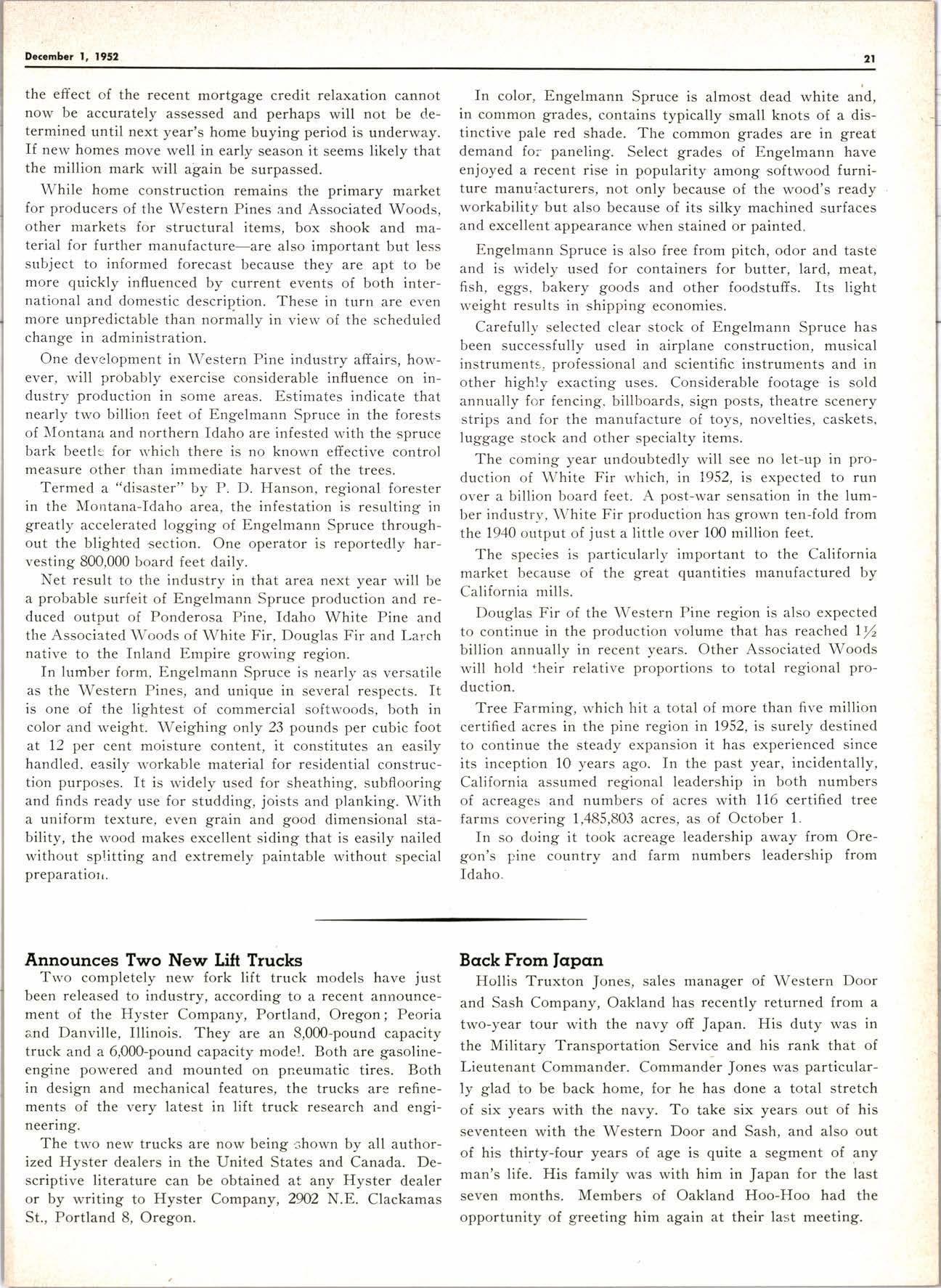
5 minute read
1952 Year 0f Unexpectedly Good Business For Western Pine Industry
By Robert O Leonurd \il/estern Pine Association
The year 1952, from the best of evidence availdble two months before it closed, will be recorded as a year of unexpectedlv good business for mills of the Western Pine region.
In all three quarters for which figures are available, shipments exceeded expectations.
The year began with forecasts that the initial quarter would fall N per cent under the record first quarter of 1951. fnstead, it wound up only four per cent behind. The total was 1368 million board feet of Western Pines and Associated Woods.
Predictions for the second quarter indicated a drop of 10 per cent under the year before but performance of 1783 million feet fell only eight per cent.
In the third quarter, expectations indicated a shipment total five per cent off 1951 but the period ended with a figure of 2015 million feet, nine per cent ahead of last year.
Cumulatively, shipments for the first three quarters of 1952 were one per cent ahead of 1951 and indications are
Empire Westem Pine mills in 1953, that fourth quarter business will match that of a year ago and bring a total for the year approximately equal to the 1951 figure of 6891 million feet, wl-rich rvas the second biggest year in pine region history.
Production, meanwhile, ran consistently behind 1951 until the third quarter when it went slightly over the third period of the year before. At the end of nine months, total output was 6.5 per cent off from 1951. The forecast is for a 1952 production total approximately five per cent under the 7260 milllon foot mark of 1951.
The crystal ball for 1953 is clouded. Although it is already evident that 1952 u.ill again be a million-start year in home construction, prospects for 1953 are not quite so rosy. The Bureau of Agricultural Economics predicts construction of betvveen 900,000 and 1,000,000 units. The U. S. Chamber of Commerce's Construction Department says 1953 hor.ne starts "seem not likely to fall below 900,000 family units."
Because i:he 7952 building season was fairly well wrapped up in most sections of the country when it was announced, the effect of the recent mortgage credit relaxation cannot now be accurately assessed and perhaps will not be d,etermined until next year's home buying period is underway. If new homes move well in early season it seems likely that the million mark will a$ain be surpassed.
While home construction remains the primary market for producers of the Western Pines and Associated Woods, other markets for structural items, box shook and material for further manufacture-are also important but less subject to informed forecast because they are apt to be more quickly influenced by current events of both international and domestic description. These in turn are even more unpredictable than normally in view of the scheduied change in administration.
One devclopment in Western Pine industry affairs, however, will probably exercise considerable influence on industry production in some areas. Estimates indicate that nearly two billion feet of Engelmann Spruce in the forests of tr{ontana and northern Idaho are infested with the spruce bark beetle follvhich there is no known effective control measure other than immediate harvest of the trees.

Termed a "disaster" by P. D. Hanson, regional forester in the Montana-Idaho area, the infestation is resulting in greatly accelerated logging of Engelmann Spruce throughout the blighted section. One operator is reportedly harvesting 800,000 board feet daily.
Net result to the industry in that area next year r,vill be a probable surfeit of Engelmann Spruce production and reduced output of Ponderosa Pine, Idaho White Pine and the Associated Woods of White Fir, Douglas Fir and Larch native to the Inland Empire growing region.
In lumber form, Engelmann Spruce is nearly as versatile as the Western Pines, and unique in several respects. ft is one of the lightest of commercial softwoods, both in color and weight. Weighing only 23 pounds per cubic foot at 12 per cent moisture content, it constitutes an easily handled. easily rn'orkable material for residential construction purposes. It is widely used for sheathing, subflooring and finds ready use for studding, joists and planking. With a uniform texture, even grain and good dimensional stability, the wood makes excellent siding that is easily nailed without splitting and extremely paintable without spe,cial preparatiorr.
Announces Two New Lift Trucks
Two completely new fork lift truck models have just been released to industry, according to a recent announcement of the Hyster Company, Portland, Oregon; Peoria and Danville, Illinois. They are an S,000-pound capacity truck and a 6,000-pound capacity mode!. Both are gasolineengine powered and mounted on pneumatic tires. Both in design and mechanical features, the trucks are refinements of the very latest in lift truck research and engineering.
The two new trucks are now being shown by all authorized Hyster dealers in the United States and Canada. Descriptive literature can be obtained at any Hyster dealer or bywriting to Hyster Company, 2W2 N.E. Clackamas St., Portland 8, Oregon.
In color. Engelmann Spruce is almost dead white and, in common grades, contains typically small knots of a distinctive pale red shade. The common grades are in great demand fo;' paneling. Select grades of Engelmann have enjoyed a recent rise in popularity among ,softwood furniture manuiacturers, not only because of the wood's ready workabilit-y but also because of its silky machined surfaces and excellent appearance when stained or painted.
Engelmann Spruce is also free from pitch, odor and taste and is widely used for containers for butter, lard, meat, fish, eggs, bakery goods and other foodstuffs. Its light weight results in shipping economies.
Carefullv selected clear stock of Engelmann Spruce has been successfully used in airplane construction, musical instruments. professional and scientific instruments and in other highlv exacting uses. Considerable footage is sold annually for fencing. billboards, sign posts, theatre scenery strips and for the manufacture of toys, novelties, caskets, luggage stock and other specialty items.
The coming year undoubtedly will see no let-up in production of White Fir which, in 1952, is expected to run over a billion board feet. A post-war sensation in the lumber industrv, White Fir production has grown ten-fold from the 1940 output of just a little over 100 million feet.
The species is particularly important to the California market because of the great quantities manufactured by California mills.
Douglas Fir of the Western Pine region is also expected to continue in the production volume that has reached lf billion annually in recent years. Other Associated Woods will hold their relative proportions to total regional production.
Tree Farming, which hit a total of more than five million certified acres in the pine region in 1952, is surely destined to continue the steady expansion it has experienced since its inception 1O years ago. In the past year, incidentally, California assumed regional leader'ship in both numbers of acreages and numbers of acres with 1i6 certified tree farms covering 1,485,803 acres, as of October 1.
In so d<.ring it took acreage leadership away from Oregon's pine countryand farm numbers leadership from Idaho.
Back From lcrpcrn
Hollis Truxton Jones, sales manager of \Mestern Door and Sash Company, Oakland has recently returned from a two-year tour with the navy ofi Japan. His duty was in the Military Transportation Service and his rank that of Lieutenant Commander. Commander Jones was particularly glad to be back home, for he has done atotal stretch of six years with the navy. To take six years out of his seventeen with the Western Door and Sash, and also out of his thirty-four years of age is quite a segment of any man's life. His family was with him in Japan for the last seven months. Members of Oakland Hoo-Hoo had the opportunity of greeting him again at their last meeting.










